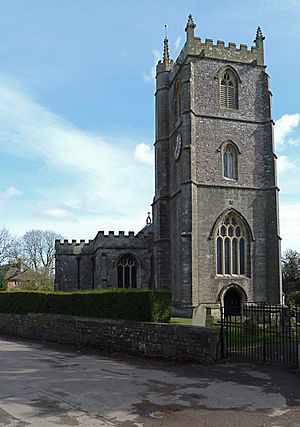Church of All Saints, Long Ashton facts for kids
Quick facts for kids Church of All Saints |
|
|---|---|
 |
|
| Location | Long Ashton, Somerset, England |
| Built | 14th century |
|
Listed Building – Grade II*
|
|
| Official name: Church of All Saints | |
| Designated | 11 October 1961 |
| Reference no. | 1138021 |
| Lua error in Module:Location_map at line 420: attempt to index field 'wikibase' (a nil value). | |
The Church of All Saints is an old church located in Long Ashton, England. It was first built way back in the 14th century, which means it's over 600 years old! Even though it's so old, many parts of the church were rebuilt in the 1870s. This church is considered a very important historical building and is known as a Grade II* listed building.
Contents
History of All Saints Church
Early Beginnings and Changes
The Church of All Saints has a long and interesting past. You can even see the special symbols, called "arms," of its founder, Thomas de Lyons, on the outside of the church tower. Inside the church, there are some beautiful old tombs. Did you know that some family members of the famous poet Robert Southey are buried in the churchyard?
The church got a big makeover between 1871 and 1872. This type of renovation is called a Victorian restoration. During this time, new parts like the chancel (the area around the altar), the vestry (a room for clergy), and a south chapel were added.
Modern Updates
Even old churches need modern updates! In 2011, the heating system in the church stopped working. To fix this, the church installed solar panels and new radiators. This helps keep the church warm using energy from the sun. In 2016, people started a special fundraising effort to replace the old stone floors, called flagstones, inside the church.
The church is part of a group of churches called a benefice. This group includes churches in Long Ashton, Barrow Gurney, and Flax Bourton. They all belong to the Diocese of Bath and Wells, which is a larger church area.
Architecture of the Church
Church Layout and Tower Bells
The Church of All Saints has a classic church design. It includes a nave (the main part where people sit), north and south aisles (walkways on the sides), a chancel, and a vestry. It also has a tall, three-story tower on the west side.
This tower is home to a peal of eight bells. Originally, there were only six bells, but two more were added in 1897. They were rehung in 1903 to make them easier to ring. The largest bell, called the Tenor, is super heavy! It weighs about 1,573 kilograms (that's over 3,400 pounds!). This makes the bells at All Saints Church the 11th heaviest set of eight bells in the world.
After 107 years of ringing, the bells were rehung again in 2010 by a company called John Taylor & Co from Loughborough. They put the bells on special modern bearings, which makes them even easier to ring.
Inside the Church
Inside the church, you can see a beautiful old rood screen that dates back to the 15th century. A rood screen is a decorative wooden or stone screen that separates the nave from the chancel. The church also has a church organ from the 19th century, which was rebuilt by J.G.Haskins & Co.
Churchyard and Memorials
Historic Gravestones
The churchyard around All Saints Church is also very historic. Many of the gravestones and memorials there are also listed buildings, just like the church itself! The oldest one is for John and Alice Smith, who passed away in 1591.
You can find several "chest tombs" here. These are like stone boxes that sit above the ground. Some of these include the tomb of Elizabeth Phelps from 1698 and Anna Whiting from 1700. There are also memorials for George Whiting (1709), Robert Whiting (1662), another Robert Whiting (1679), and yet another Robert Whiting (1693). These chest tombs have cool old designs from the Renaissance period and are an important historical collection.
Other memorials in the churchyard honor people like Philip Bower, the Pomroy family, the Ford family, Elizabeth Hayward, William Cambridge, William Poultney James Miller, and John Howard.
The Churchyard Cross
There's also an interesting octagonal (eight-sided) churchyard cross in the churchyard. This cross is very old, from the late medieval period. It was moved to its current spot in the late 19th century.

